- Storage Options
- Storage System
- New User - System Administrator
Contact Support
Application Startup
This topic describes how to configure the Syncfusion Dashboard Server.
Application startup screen help you configure storage options and to register a new user.
Storage Options
Dashboard Server stores the user management data in the following databases as you select in the first screen.
* SQL CE
* SQL Server
* MySQL
* Oracle
* PostgreSQL, Azure-PostgreSQL
* AWS Aurora (Please click here to know how to configure AWS Aurora)
-
Embedded SQL CE (For Testing purposes only)
Installed along with Dashboard Server Installer to easily set the environment up for testing purposes.
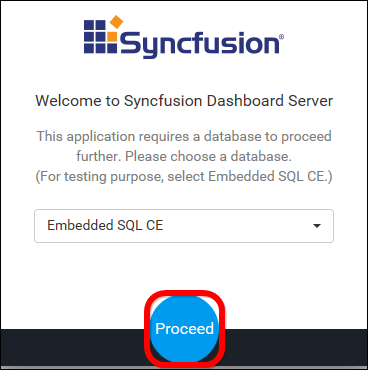
NOTE
Since it is an Embedded Database, we do not have option to create database from Azure App service.
-
SQL Server
Can connect to the existing SQL Server instance with the below options.
-
Create new
Syncfusion Dashboard Serverdatabase.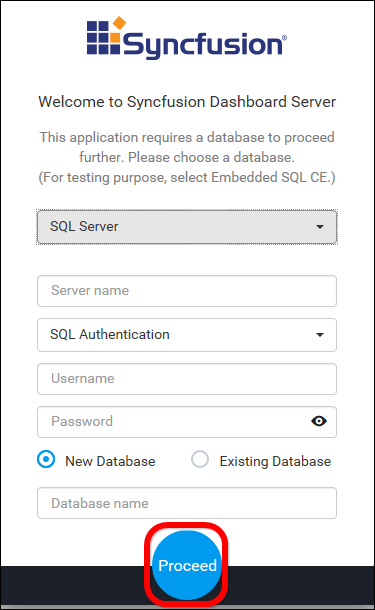
- Use an existing database for
Syncfusion Dashboard Server. - Choose one of the database from
Select a Databasedrop down for creating Dashboard Server tables in that database. -
In order to avoid table name conflicts, we have added a prefix
SyncDS_by default. It can also be changed. If the prefix is empty, the default prefixSyncDS_is added.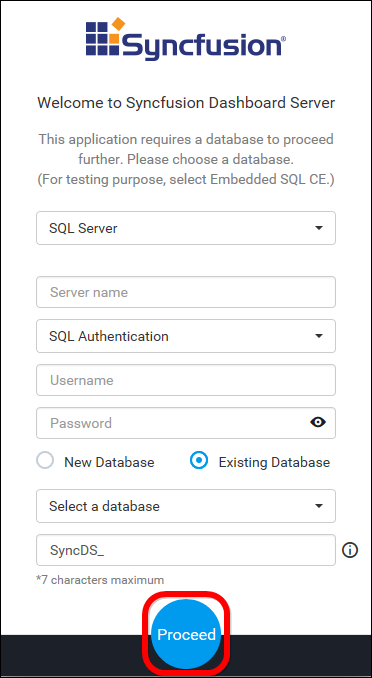
NOTE
The credentials that is given to connect to the SQL Server instance must have permissions to
- Create Database
- Create Table
- Insert
- Update Table
- Alter Table
- Select
- Drop Table
- Drop Database
The SQL Server within an elastic pool can also be supported in the Syncfusion Dashboard Server.
-
-
MySQL
Can connect to the existing MySQL instance with the below options.
-
Create new
Syncfusion Dashboard Serverdatabase.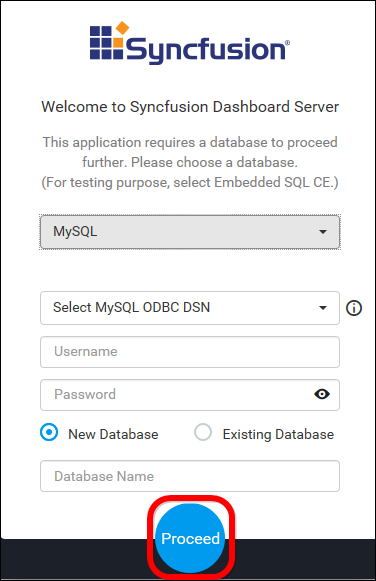
- Use an existing database for
Syncfusion Dashboard Server. - Choose one of the database from
Select a Databasedrop down for creating Dashboard Server tables in that database. -
In order to avoid table name conflicts, we have added a prefix
SyncDS_by default. It can also be changed. If the prefix is empty, the default prefix “SyncDS_” is added.
NOTE
The credentials that is given to connect to the MySQL instance must have privileges to
- Create
- Delete
- Insert
- Update
- Alter
- Select
- Drop
- Show Databases
We do not have option to create database from Azure App service.
-
-
Oracle
Can connect to the existing Oracle instance with the below options.
-
Create new
Syncfusion Dashboard Serverdatabase.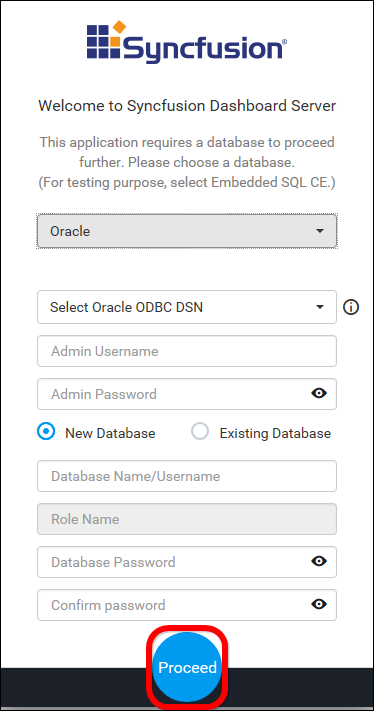
- Use an existing database for
Syncfusion Dashboard Server. - Choose one of the database from
Select a Databasedrop down for creating Dashboard Server tables in that database. -
In order to avoid table name conflicts, we have added a prefix
SyncDS_by default. It can also be changed. If the prefix is empty, the default prefix “SyncDS_” is added.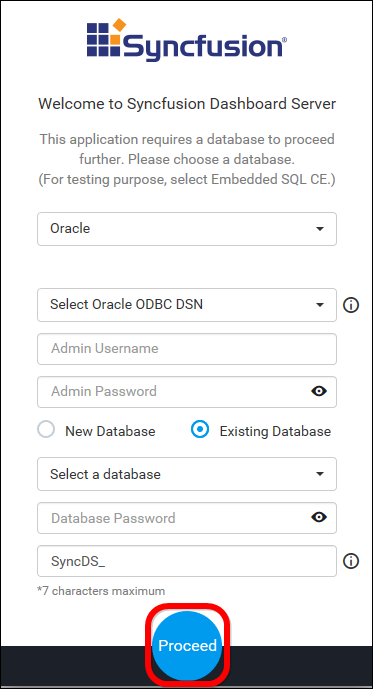
NOTE
The credentials that is given to connect to the Oracle instance must have permissions to
- Create Database
- Create Role
- Grant Role
- Grant Permission
- Drop Database
We do not have option to create database from Azure App service
-
-
PostgreSQL
Can connect to the existing PostgreSQL instance with the below options.
-
Create new
Syncfusion Dashboard Serverdatabase.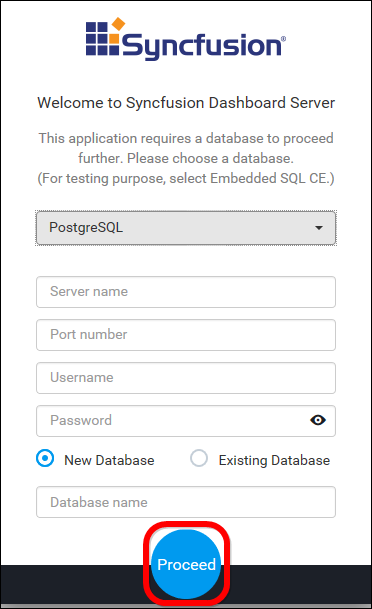
- Use an existing database for
Syncfusion Dashboard Server. - Choose one of the database from
Select a Databasedrop down for creating Dashboard Server tables in that database. -
In order to avoid table name conflicts, we have added a prefix
SyncDS_by default. It can also be changed. If the prefix is empty, the default prefix “SyncDS_” is added.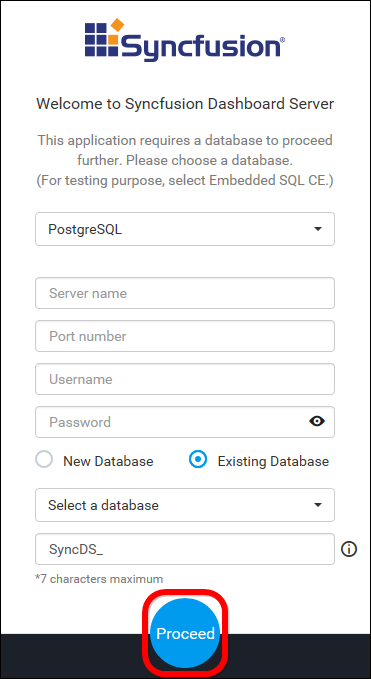
NOTE
The credentials that is given to connect to the PostgreSQL instance must have permissions to
- Create Database
- Create Table
- Insert
- Update Table
- Alter Table
- Select
- Drop Table
- Drop Database
-
Dashboard Server is deployed in the below location by default.
{Windows_Drive}\Syncfusion\Dashboard Server\DashboardServer.Web\
For example, C:\Syncfusion\Dashboard Server\DashboardServer.Web\
Dashboard Server stores the dashboard, data source and widget files that are uploaded to the server in the following location as file system.
{Windows_Drive}\Syncfusion\Dashboard Server\DashboardServer.Web\App_Data\Resources
Also, an option to create a database from the Azure PostgreSQL has been provided.
Storage System
File Storage
The default system is File Storage, in this the Dashboard Server stores the dashboards and data sources that are uploaded to the server in the following location in the installed machine.

Blob Storage
If the Dashboard Server wants to store the dashboards and data sources that are uploaded to the server in the blob storage location, need to provide details shown in below figure.

You can find the details on How to configure the Azure Blob here
New User - System Administrator
New user should be created to access the dashboard server with the details mentioned in the below image.
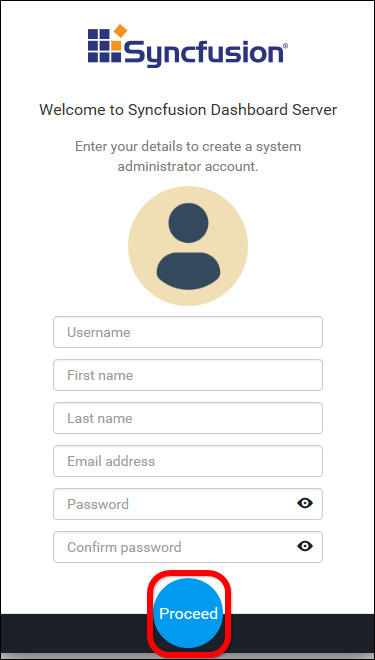
While creating this new user account, a new group System Administrator is also created.
By default, System Administrator group have permission to do the below
- Create Dashboards
- Create Data Sources
- Create Schedules
- Create Users
- Create Groups
- Manage Permissions for users and groups
The new user account created is assigned to this group by default.
